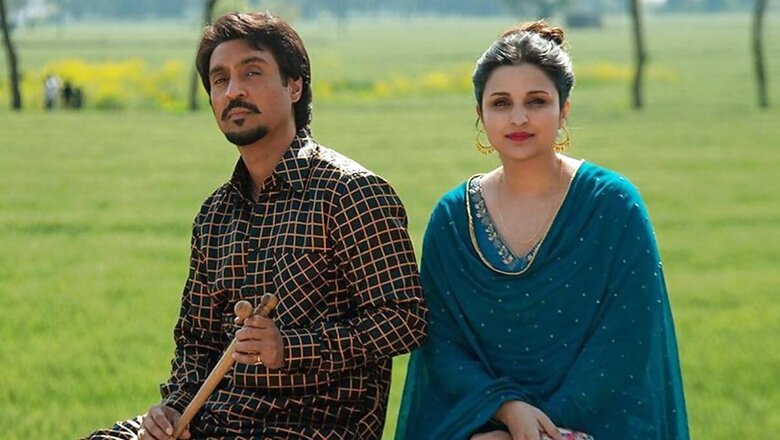
views
Amar Singh Chamkila Movie Review: Ever since the release of Jab Harry Met Sejal, the one question that has been haunting cinephiles is, when will Imtiaz Ali be back in his signature form? According to many, the director who had redefined modern day relationships through flawed characters, nuanced storytelling, messy stories of love and idyllic journeys of self-love, somewhere lost the plot. So, the big question now is, has he been able to bounce back with Amar Singh Chamkila?
Well, there’s no absolute answer to that. It’s a bit of yes and a bit of no. Much like Socha Na Tha, Jab We Met, Love Aaj Kal, Rockstar and Tamasha, a love story forms the heart of Amar Singh Chamkila, except that this time, the protagonist has a deep and divine love affair with his music. The story is heart-wrenching and Imtiaz tells it with utmost honesty and earnestness. But to be honest, the filmmaker already had a stellar story laid out before him and all he had to do is weave it together by sprinkling some cinematic magic, which he somewhat manages to do. But despite its soul and intent being in the right place, Amar Singh Chamkila lacks the simplicity of Socha Na Tha, the sparkle of Jab We Met, the intricacies of Love Aaj Kal, the wringing agony of Rockstar and the gravity of Tamasha.
As the title suggests, Amar Singh Chamkila is the story of the eponymous folk musician, who was Punjab’s highest-selling artist of his era. The film opens with a sequence set in Mehsampur in 1988 that startles you and then in a flashback, gives you glimpses of Chamkila’s life. Born to a poor family, he spent his young adolescence years working at a factory that manufactures socks. Music has always been his one true passion and soon, he joins a famous singer Jatinder Jinda’s team.
During one of his akharas in Chandigarh, Chamkila serendipitously takes to stage with his tumbi and leaves everyone mesmerised with his rustic vocals and quirky song lyrics. Shortly after, offers start pouring in for him to perform at celebratory events and he becomes an instant sensation. He is soon joined by Amarjot Kaur, who later becomes his wife, both of who change the face of Punjabi folk music as they travel from one village and town to another, leaving the audiences enraptured and spellbound.
While Chamkila enjoys a massive fan base, on the other hand, many start calling out his music for being obscene and offensive. He gets reprimanded and even threatened for penning lyrics laden with sexual innuendos, which apparently have been tarnishing the Punjabi society. This eventually takes a catastrophic shape and Chamkila and Amarjot face a fatal consequence for not bowing down to threats.
Imtiaz renders a unique treatment to Amar Singh Chamkila. In a rarity, his protagonists Diljit Dosanjh and Parineeti Chopra record live songs while shooting. And the outcome is mesmerising to say the least. The duo croons Chamkila and Amarjot’s original compositions and these musical pieces hold the film up even when the screenplay starts falling flat. The makers provide real-time translations of the songs onscreen and though that helps the audience understand why Chamkila was also considered a threat to society, it gets monotonous after a point of time. Soon, you’ll find yourself confused – if you should focus on the scenes or the words onscreen.
The film transports you to the Punjab of the 1970s and the 1980s and along with Imtiaz, cinematographer Sylvester Fonseca deserves a big round of applause for the same. It’s a beautiful film to look at. The sepia tints and the spirit of small-town Punjab add to its vintage charm. The dialect, however, is so strong and rooted to culture that it gets difficult to wrap your head around the dialogues. The random inclusion of animation to important sequences also seems redundant. Having said that, the film boasts of some extraordinary and magical moments and it is these vignettes that make Amar Singh Chamkila an unforgettable experience.
With the film, the terrific quartet of Imtiaz, AR Rahman, Mohit Chauhan and Irshad Kamil reunites and truth be told, it’s almost divine and mystical as to how they contribute in unravelling this audio-visual extravaganza called Amar Singh Chamkila, onscreen. The film starts off with the goose-flesh inciting track Baaja and it perfectly sets the tone of the narrative. It captures the essence of the life and the times of the rebellious, ‘sexila’ and ‘tharkila’ Chamkila and his homeland Punjab with aplomb, and the coming together of some awe-inspiring instruments with Mohit’s raspy voice is just a treat!
In fact, watching Amar Singh Chamkila feels like experiencing a sublime and breathtaking concert, one that will stay with you for a very, very long time. The eclectic blend of Rahman’s tunes with Chamkila’s folksy compositions is the biggest highlight of the film. Be assured that you will find yourself humming Bapu Sada Gum Ho Gaya for days to come. Much like any other music album of an Imtiaz film, the songs of this one will grow on you like slow poison. The passion of Ishq Mitaye and its visuals will remind you of Sadda Haq. Tu Kya Jaane is a maudlin form of Katiya Karun and its stunning visuals will once again remind you why Imtiaz is revered for reviving love stories in Bollywood. The paradox of restraint and frenzied intensity that first love is synonymous with is beautifully portrayed in this love ballad.
On the surface, the musical has every element to make it a compelling piece of narrative. And yet, it lacks the raw intimacy of a quintessential Imtiaz Ali film. The writing suddenly nosedives into the second half and the presence of some heart-wrenching moments somehow fail to tug at your heartstrings. The road to Chamkila’s sudden success isn’t properly established either. But maybe that’s because the euphoria surrounding him and his speedy rise to bonafide stardom is inexplicable.
Imtiaz dedicates the second half of the film to making a statement on separating the art from the artist and how art is often expected to adhere to a moral compass and is subjected to unjust scrutiny leading to threats of censorship. Not much has changed, has it? Chamkila had throngs of fans – some who loved him openly and some who opposed his music and called it debauchery but still listened to him secretly. Subsequently, it was his passion that led to his debacle. And yet he always believed that his tumbi was mightier than a sword.
Amar Singh Chamkila is a paradox and a commentary on the fact that ‘art should comfort the disturbed and disturb the comfortable’ and that ‘it either upholds or disrupts the status quo, advancing or regressing justice’. The universal appeal and relevance of the story makes it chaotic and striking, all at once.
Diljit delivers a stupendous act as the protagonist. The character of Amar Singh Chamkila is tailor made for him and he pours his heart out into it. His hard work is palpable and yet his performance is effortless. Watching him become Chamkila and sing his songs will fill your heart up with unadulterated joy. Even in some heavy-weight scenes, he brings a rare restraint to the fore and renders a whole new layer of poise. It, inarguably, is his career-best performance. And somewhere in the middle, you will see him becoming one with Chamkila and very soon, you won’t be able to separate these forces that forever changed the music industry of Punjab.
Parineeti, who plays Amarjot, however underwhelms in bits and parts. Diljit overshadows her in the scenes where she’s seen performing with Chamkila and she doesn’t quite manage to channel the vivaciousness of Amarjot. But she stands out in Tu Kya Jaane as a love-struck woman who has madly fallen in love but is unable to express it due to societal and personal constraints. As for the rest of the film, she doesn’t get much to do as the story circumnavigates around Chamkila. Her character, unfortunately, is only scratched from the surface and just gets relegated as ‘Chamkila’s wife’. A deeper dive into Amarjot’s life and conflicts would have definitely added more substance to the plot. The film, however, gives us a sneak peek into Parineeti’s musical prowess and she ably matches vocals with Diljit in the scenes wherein they sing live.
Amar Singh Chamkila might not exactly be an antidote to Jab Harry Met Sejal and Love Aaj Kal. But it deserves a watch for Imtiaz’s fervent passion, Diljit’s grit and mettle, Rahman’s extraordinary tunes and Chamkila’s dignified bravado. It’s not every day that you get to witness a delightful concert packaged in the form of a musical. It might not be wholesome but is definitely a wholehearted attempt. After all, celebration of art against all socio-political prejudices and violence is what the world has always needed and craved for.













Comments
0 comment